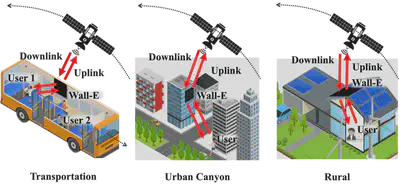Wall-E: dual-band metasurfaces for satellite networking

Wall-E is an electronically tunable surface mounted on a window/skylight, either refracting the satellite link into the home directly or reflecting signals to support outdoor users. Owing to angular reciprocity, Wall-E can simultaneously steer the downlink and uplink beams at the same angle, speeding up the beam alignment process for the uplink via downlink, and vice-versa. Additionally, Wall-E supports soft handovers by allowing two (or multiple) satellites impinge on the surface at the same time, thus reducing network jitter during handovers. A key obstacle in designing the surface is the frequency duplex division (FDD) in LEO networks, which complicates operation due to the use of different frequency sub-bands in the uplink (upper Ku band) and downlink (lower Ku band) directions. Wall-E is the first of its kind to target dual channels in the Ku radio frequency band.